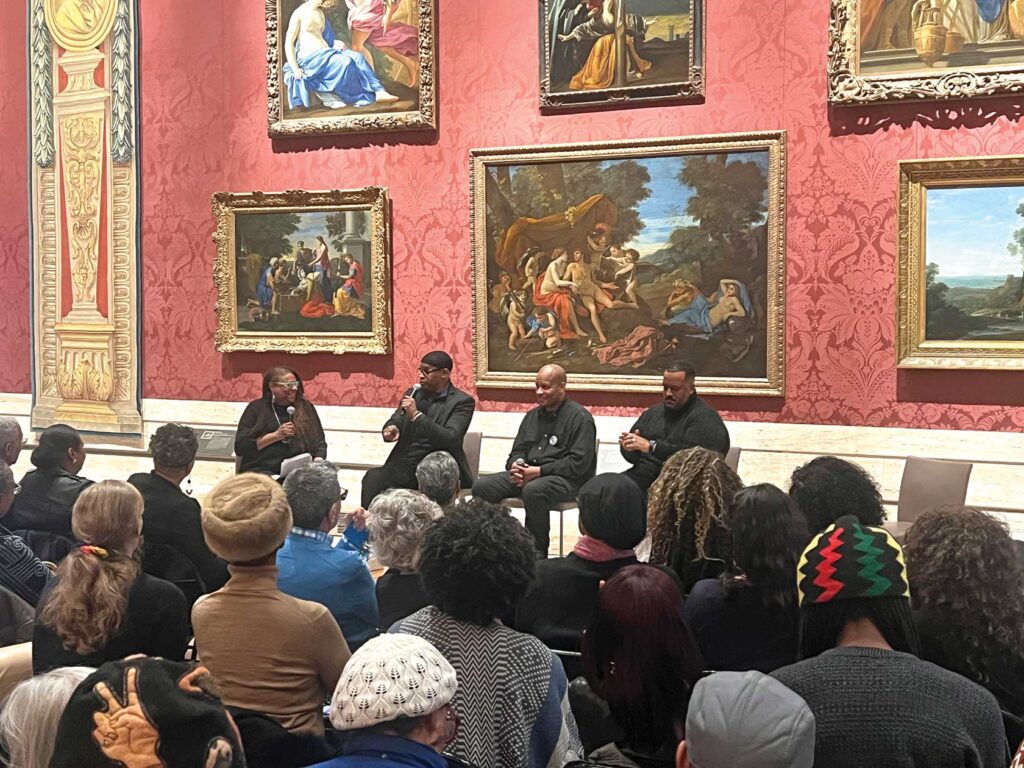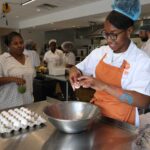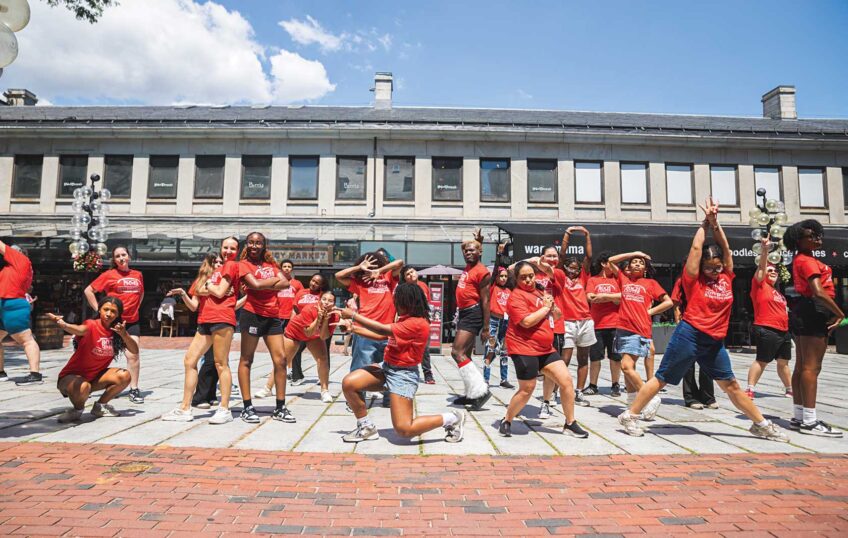Banner Art Gallery roundtable hosted at Museum of Fine Arts (Part 2)

Banner [Virtual] Art Gallery sponsored by the City of Boston | Mayor Michelle Wu
On Feb. 29, about 130 enthusiastic supporters of Black art gathered at the Museum of Fine Arts Boston’s William I. Koch Gallery to attend a [Virtual] Art Gallery roundtable, themed “The City Talks: Black Art in Colonial Spaces.”
Presented by the Museum of Fine Arts Boston and the Bay State Banner, the roundtable featured six of New England’s leading Black visual artists who have been spotlighted in the Banner’s [Virtual] Art Gallery series: Robert Freeman, Ekua Holmes, Paul Goodnight, Shea Justice, James Perry and Robert Stull. Banner editor and publisher Ron Mitchell and mixed-media artist L’Merchie Frazier moderated the event.
In last week’s Banner, we reported on part one of the roundtable, which featured Freeman, Holmes and Goodnight. This week we report on part two of the event, which featured Justice, Perry and Stull.
Frazier asked the artists about their work and what drove them to be artists.
Justice, whose sobering series of collages and drawings place American racism in sharp relief against the backdrop of the U.S. Constitution, spoke first.
“What motivates me is my family, number one: my late mother, my father, my aunts, uncles and cousins. I love my mother to death and always carry this [picture] with me to carry her and her spirit with me,” he said.
When he went to college, Justice said, he got into the study of history, particularly African American history.
“If you look at what’s going on currently, many of our histories and stories are being erased, particularly in places like Florida and Texas,” he said. “I’m fascinated by those stories. They mean a lot and are important to me, and I think they would mean a lot to younger people.”
He was also motivated by artist and activist Dana Chandler.
“Chandler’s murals were all over Roxbury. [They] were subtle and inspiring to me,” he said. “I wanted to do that. Ever since then, it’s been the trajectory of where I’ve gone as an artist, as an individual and as a human being. I just continue the Dana Chandler trajectory of our stories, our realities, our experiences. They matter. Black lives matter, and I’m going to reflect that in my work no matter what.”
Stull said, “When I think about how I found my way to be expressive visually, I have to take it back to my youth. As a young child, you need something visually to connect and identify with, something that gives you confirmation that this is a lane you can travel in, that this is a space that you can exist in. And I needed that confirmation as a kid.”
Because Stull’s parents had an appreciation for the arts, he had art in the home that he could visually connect and identify with.
“I didn’t think about [the MFA] because I hadn’t seen that confirmation. I saw it on the walls of my home as I was growing up,” said Stull. “The confirmation came through works like Paul Goodnight’s, Renée Neblett’s, Barbara Ward’s, Allan Rohan Crite’s and so on. I identified that as success, and that’s what I wanted to aspire to — to have my work hanging on someone’s wall one day. I knew beyond a shadow of a doubt at an early age that this was what I wanted to do. I had access by way of my parents to these amazing artists who were right there in the community.”
Perry said, “Anyone that knows me well knows that I’m a deeply religious person. So I always think that success is in two components: It’s from above and it’s from your friends and family who support you. And I see so many folks in this room: Paul, my wife, my brother-in-law, my brother [and] patrons of mine who allow me to do what I do. Advocates, family, friends and God is what I think really allows you to be in this kind of place. That’s the reason I create.”
He continued, “But a little bit of my back story. I’m kind of new to the game. Everybody is more established than me. I guess my story really started here in these museum halls. I walked through these halls with my father and my mother, and walking in these kinds of galleries, I would create from a very young age. It’s actually weird. It started with dinosaurs. I used to draw dinosaurs. I still do.”
He added, “I looked at the faces in these galleries and they didn’t connect with me. So as I grew older, I realized why can’t I draw our people in these beautiful pieces. Shea [Justice] was my high school art teacher. [He] and people like Paul and many others who are on this panel always encouraged me to create no matter what. I challenged myself over time to make sure that I produced images that reflected people who I saw in my everyday life — my family and friends.”
Frazier also asked the artists, “What does it mean to have your art in these traditional spaces — in these colonial spaces?”
Justice replied, “I don’t know yet because I haven’t been in a situation where my work was in a colonial space where I felt it had the impact that I would like it to have. I’m privileged to be in exhibits and will continue to do that, but I’ve yet to be in the kind of exhibition where I want to be — to have the kind of impact that I’m hoping [for].
Perry said, “I guess I can talk from past experiences about the impact of having Black art in colonial spaces. One exhibit that impacted me as a very young man was coming to [the MFA] and seeing Dr. [John] Biggers’ work. Please don’t tell anybody I skipped school to see it, but it was worth it because Paul [Goodnight] was there. He introduced me to Dr. Biggers. To see everyone come out, to see Dana Chandler there [was worth it.] Growing up in Boston, we didn’t have these kinds of exhibits in these spaces, so it was strange and bizarre to see our people. John made massive works that showed the beauty and elegance of our people.”
Stull said, “How does it make me feel to be represented in these spaces? It’s amazing. That’s the feeling that I felt. And it doesn’t stop you from continuing to do your thing.”









